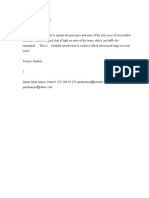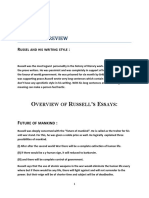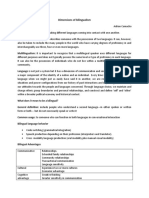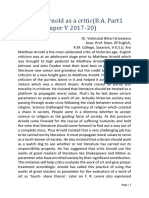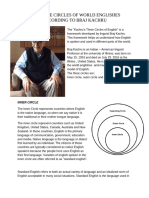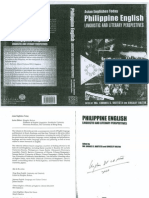Sociolinguistics Sapir Whorf
Sociolinguistics Sapir Whorf
Uploaded by
Iris DelacroixCopyright:
Available Formats
Sociolinguistics Sapir Whorf
Sociolinguistics Sapir Whorf
Uploaded by
Iris DelacroixOriginal Description:
Copyright
Available Formats
Share this document
Did you find this document useful?
Is this content inappropriate?
Copyright:
Available Formats
Sociolinguistics Sapir Whorf
Sociolinguistics Sapir Whorf
Uploaded by
Iris DelacroixCopyright:
Available Formats
Sapir whorf theory: Introduction:
The linguistic relativity principle, or the SapirWhorf hypothesis, is the idea that differences in the way languages encode cultural and cognitive categories affect the behave differently depending on the language they use. The hypothesis is generally understood as having two different versions: (i) the strong version that language determines thought and that linguistic categories limit and determine cognitive thought and certain kinds of non-linguistic behavior
way they people think, so that speakers of different languages will tend to think and
categories and (ii) the weak version that linguistic categories and usage influence
reality which is perceived in thought. Perception and expression are frequently understood to be synonymous and it is assumed that our speech is based on our
It is often thought that the reality expressed in spoken word is the very same as the
thoughts. This idea presumes that what one says is dependant of how it is encoded one perceives is dependent on the spoken word. To the followers of this idea, Lee Whorf are known for their part in the popularization of this very
and decoded in the mind. However, there are many that believe the opposite: what thought is dependant on language. Linguist Edward Sapir and his student Benjamin principle. Their collective theory, know as the Sapir-Whorf Hypothesis or more all communication theory. The theory also fulfills the criteria, which essentially determine its workability.
commonly the Theory of Linguistic Relativity, holds great significance in the scope of
reality. It is a mould theory in that it represents language as a mould in terms of language-what you see is based on what you say.
The Theory of Linguistic Relativity holds that: ones language shapes ones view of
which thought categories are cast. More basically, it states that thought is cast from
Linguistic Determinism and Linguistic Relativity. The first part, linguistic
The Sapir-Whorf Hypothesis can be divided into two basic components:
determinism, refers to the concept that what is said, has only some effect on how concepts are recognized by the mind. This basic concept has been broken down even further into strong and weak determinism.Strong determinism refers to a an experiment done by two Australian scientists, Peterson and Siegal, this view of
strict view that what is said is directly responsible for what is seen by the mind. In determinism is shown to be supported. In the experiment, deaf children view a doll, which is placed a marble in a box. The children then see the marble removed and placed in a basket after the doll is taken away. They are later asked where they
believe the doll will look for the marble upon returning. Overwhelmingly, the deaf deaf children with non-deaf parents answer mostly incorrectly.
children with deaf parents answer correctly (that the doll will look in the box). The
parents have communicated with them through complex sign language and their being able to get the correct answer. The children, having grown up in an environment with complex language (American Sign Language) recognized that the doll would probably look to where she had placed the marble. The other children, who had not grown up in a stable linguistic environment (their parents not being hearing impaired and thus not being fluent in ASL) were not able to see the Sapir-Wharf Hypothesis was correct according to strong determinism
The experiment showed clearly the relationship between deaf children whose
relationship. These results lead the experimenter John R. Skoyles to believe that the
indeed some affect on perception of ones language, but that this is not as clear as in strong determinism. For instance, in weak determinism language does not define by language. ones view of the world, whereas, in strong determinism this view is defined strictly
The other view on determinism, weak determinism, recognizes that there is
part of the hypothesis can be defined: distinctions encoded in one language are
The second division of the Sapir-Whorf Hypothesis is linguistic relativism. This
unique to that language along, and that there is no limit to the structural diversity of languages (The Sapir-Whorf Hypothesis, p.1). As stated by Sapir himself:
social activity as ordinarily understood, but are very much at the mercy of the particular language which has become the medium of expression for their societyThe fact of the matter is that the real world is to a large extent
Human beings do not live in the objective world alone, nor alone in the world of
unconsciously built on the language habits of the groupWe see and hear and otherwise experience very largely as we do because the language habits of our community predispose certain choices of interpretation.
This view of cognition can be more simply defined as meaning: the language which will think and perceive the world in.
one is brought up in (socially exposed to and taught) is the language that that person
not translate to each other. One such example is of the Punjabi word joot. This word in its most literal translation to English means the unclean, not pure, or
Linguistic relativity opens the window to the realization that all languages do
with-germs (as in half eaten food). No matter how many definitions one tries to
constructjoot cannot be translated in its full meaning. This brings to mind that
notion that language is relative, thus the same word can have different meanings for different people and these subjective meanings let rise varying cognitions. Linguist Ferruccio Rossi Landi paraphrases that the formal relationships of language exert an influence on the rest of social life and on the way of thinking of the speaker of that language(Language As Work & Trade, 1983, p.114).
Hypothesis very pragmatically presents this. The first concept provided within the theory, linguistic determination, makes sense when applied to reality. In actual thought one does indeed perceive concepts and objects in accordance to the words
Indeed language does have an affect on thinking and the Sapir-Wharf
used to describe them. In a personal experiment I individually asked a group of my
peers what they saw (in their minds-eye) when I said the word table. More than half of them saw a dinning table, a few saw a coffee table, and one saw a mathematical table. This showed me that although all of the responses I received one broad word: table.
had specific names (dining table, coffee table, etc.), their naming was triggered by
my inquiry into the second portion of the theory, linguistic relativity. I then went and asked an elderly relative of mine from India if they were aware of a word for word for coffee tableso if they were asked to visualize a coffee table when they were younger and still in their birth nation they would never have cognitively word for table, the word mech, and it refers to a dining table.
After determining that this portion did indeed make good sense to me I continued
coffee table in Punjabi (my ethnic language) and the response was no. There is no
recognized a coffee table (considering they were monolingual). There is only one
evaluation and meets them very well. The first of these criteria is that of the
The Sapir-Whorf Hypothesis addresses the criteria that are set forth for
theoretical scope. This criterion refers to the comprehensiveness of a theory. When see that there are many possibilities: all of thought to be more accurate. Everything that is encoded and decoded and the language used by society and cultures used all are encompassed in this theory.
looking at what is included in the possible factors of analysis for this theory, one can
language by which one is surrounded has an affect on how they decode and that
Appropriateness is also achieved by this theory. The theory expects that the
encoding differs from language-to-language and cannot always be translated. In
experimentation this has been tested and then shown. In my experiment, mentions images, all because of the receivers different experiences with the word. This was
earlier, I anticipated that the word table would bring to different minds--different then proven when I actually asked the question. This experiment also supports the heuristic value of the theory. At the time of my experiment I had not even thought
of the heuristic value of the hypothesis. The theory so interested me that I just did the experiment as a means of personally verifying its validity.
criteria. From the experiment as well as from earlier, more notable ones it can be noted that this theory holds great value. It also accomplishes correspondence times. validity because the theory is very observable and has been observed numerous
This validity, which was tested and found to be supported, is the next of the
sound. It makes complete sense that ones atmosphere and culture will have an
Furthermore, the Sapir-Whorf Hypothesis is very simple and logically
affect on their decoding. Referring back to the elderly Punjabi, they did not grow up with coffee tables; therefore, it did not come to mind. Likewise, in research done by the authors of the theory, many Indian tribes do not have word for certain objects because they do not exist in their lives. The logical plainness of this idea of relativism clearly provides parsimony.
successfully. The theory is shown as a window through which to view the cognitive process, not as an absolute. It is set forth to be used in looking at a phenomenon differently than one usually would.
Finally, the Theory of Linguistic Relativity also achieves openness
be used in describing a great many misunderstandings in everyday life. When one says a Pennsylvanian says yuns it doesnt make any sense to a Californian, but
Pragmatically the Sapir-Whorf Hypothesis makes sense. It has the potential to
when examines it is just another word for you all. The Linguistic Relativity Theory addresses this and points out that it is all-relative. This notion of relativity, passes beyond dialect boundaries, and delves into the world of language--from county-tocountry and consequently from mind-to-mind. Is language reality truly a ward of thought or is it thought which occurs because of language. The Sapir Wharf and thus forming in thought.
Hypothesis very transparently presents a view of reality being expressed in language
You might also like
- Curriculum Map - GRADE 7 (2022-2023)Document4 pagesCurriculum Map - GRADE 7 (2022-2023)Nikki Anne Berlanas100% (2)
- Group 4 - Solidarity and PolitenessDocument15 pagesGroup 4 - Solidarity and Politenessani100% (1)
- Themes in The Sea by BONDDocument6 pagesThemes in The Sea by BONDIris Delacroix63% (8)
- Adh QuotesDocument2 pagesAdh QuoteshappytingsNo ratings yet
- Postmodernism in Samuel BeckettDocument11 pagesPostmodernism in Samuel BeckettIris Delacroix100% (1)
- ELS Module 1: English DiscourseDocument3 pagesELS Module 1: English Discoursemark ervin arguillasNo ratings yet
- Stylistics GRP 2.pdf - 20231204 - 213200 - 0000Document31 pagesStylistics GRP 2.pdf - 20231204 - 213200 - 0000Ammi KhanNo ratings yet
- Linguistic InequalityDocument5 pagesLinguistic InequalityZahid GujjarNo ratings yet
- Summary of Knowledge and UnderstandingDocument2 pagesSummary of Knowledge and Understandingsana saadiaNo ratings yet
- Cognitive StylesDocument8 pagesCognitive Stylesapi-279926044No ratings yet
- Assignment On Formal LinksDocument4 pagesAssignment On Formal LinksSadiq ur Rehman 1947-FLL/BSENG/F18No ratings yet
- Success Is Counted SweetestDocument4 pagesSuccess Is Counted SweetestniklaskiddNo ratings yet
- 07 Chapter 2Document62 pages07 Chapter 2Muhammad Asim Hafeez ThindNo ratings yet
- Ijciss V2i42024871Document10 pagesIjciss V2i42024871Javed MohsinNo ratings yet
- STYLISTICS: Related Discipline: Phonology - Is The Study of The Patterns of Sounds in A Language and Across LanguagesDocument6 pagesSTYLISTICS: Related Discipline: Phonology - Is The Study of The Patterns of Sounds in A Language and Across LanguagesaninO9100% (1)
- Of DiscourseDocument13 pagesOf DiscourseRaj KatkarNo ratings yet
- Third World FeminismDocument17 pagesThird World Feminismratulnandi123No ratings yet
- MA English Part 2: Paper 4 (Literary Criticism) All Important NotesDocument51 pagesMA English Part 2: Paper 4 (Literary Criticism) All Important Notesmujeeb ur rahmanNo ratings yet
- Abrogation and AppropriationDocument3 pagesAbrogation and AppropriationRangan Zaman100% (2)
- A Stylistic Analysis of The Prolog of The Novel Moth Smoke by Mohsin HamidDocument12 pagesA Stylistic Analysis of The Prolog of The Novel Moth Smoke by Mohsin HamidDoCter TechnologyNo ratings yet
- Lecture 4, Thinking Like A Researcher Understanding Concepts, Constructs, Variables, and DefinitionsDocument43 pagesLecture 4, Thinking Like A Researcher Understanding Concepts, Constructs, Variables, and Definitionsriaz6076No ratings yet
- Ahmed Ali A WriterDocument7 pagesAhmed Ali A WriterjiaNo ratings yet
- Feminism in The Fiction of Bapsi SidhwaDocument11 pagesFeminism in The Fiction of Bapsi SidhwaYasir AslamNo ratings yet
- Relation Literature & LifeDocument3 pagesRelation Literature & Lifefiza imranNo ratings yet
- The Heart Divided: A Post Colonial Perspective On Partition: AbstractDocument11 pagesThe Heart Divided: A Post Colonial Perspective On Partition: AbstractShafaNo ratings yet
- Chapters of Biographia LiterariaDocument7 pagesChapters of Biographia Literariashah nawazNo ratings yet
- ProseDocument7 pagesProseL'Aurore0% (1)
- Write Down Salient Features of Pakistani Authors in Pakistani English LiteratureDocument2 pagesWrite Down Salient Features of Pakistani Authors in Pakistani English LiteratureNadeem HassanNo ratings yet
- Word Formation and Structure: Derivational PatternsDocument10 pagesWord Formation and Structure: Derivational PatternsKaosar ZamanNo ratings yet
- Launching The Angles by Bapsi Sidhwa SummaryDocument3 pagesLaunching The Angles by Bapsi Sidhwa Summarymk8060691No ratings yet
- Catherine Belsey S Critical Practice A Critical AnalysisDocument43 pagesCatherine Belsey S Critical Practice A Critical AnalysisNayana Thampi100% (5)
- Symbolism in Yeats PoetryDocument14 pagesSymbolism in Yeats PoetrykaviykyNo ratings yet
- The Evaluation of Foreign-Language-TeacherDocument20 pagesThe Evaluation of Foreign-Language-TeacherRODRIGO EDUARDO SANTIBÁÑEZ ABRAHAMNo ratings yet
- Assignment Prose by Maam HadeeqaDocument3 pagesAssignment Prose by Maam HadeeqaDanyal Nadeem100% (1)
- On Attributive and Referential UseDocument27 pagesOn Attributive and Referential UseRichard RodríguezNo ratings yet
- Traditional and Individual Talent by Thomas Stearns Eliot (1888-1965Document11 pagesTraditional and Individual Talent by Thomas Stearns Eliot (1888-1965shakeelaNo ratings yet
- Question#4 Answer: Psychoanalytic TheoryDocument14 pagesQuestion#4 Answer: Psychoanalytic Theorymuneeba khanNo ratings yet
- Myth of RainDocument3 pagesMyth of RainSoupenheimNo ratings yet
- Sir Rizwan Ghani AssignmentDocument5 pagesSir Rizwan Ghani AssignmentSara SyedNo ratings yet
- Dimensions of BilingualismDocument2 pagesDimensions of BilingualismWatson CriticonNo ratings yet
- Modality and PolarityDocument7 pagesModality and PolaritySaira QasimNo ratings yet
- Ice Candy Man PostDocument4 pagesIce Candy Man PostMukaberNo ratings yet
- Matthew Arnold As A CriticDocument2 pagesMatthew Arnold As A CriticAnkur AryaNo ratings yet
- The Faerie Queene Book 1, Canto 1Document1 pageThe Faerie Queene Book 1, Canto 1evelynjlt813No ratings yet
- Russell's Essays SumaryDocument30 pagesRussell's Essays Sumaryzeeshan100% (1)
- An Assignment of Applied LinguisticsDocument4 pagesAn Assignment of Applied Linguisticsظہیر عباسNo ratings yet
- Language Production: Presented by Muhammad Saleem & Abid Hussain Assigned by Ma'Am SanaDocument20 pagesLanguage Production: Presented by Muhammad Saleem & Abid Hussain Assigned by Ma'Am SanaBaloch Karawan100% (1)
- Discourse Study Notes by Mjunaidswabian... LatestDocument91 pagesDiscourse Study Notes by Mjunaidswabian... LatestMuneeba HussainNo ratings yet
- Aphoristic Style of BaconDocument2 pagesAphoristic Style of Baconmanazar hussain100% (1)
- MorphologyDocument13 pagesMorphologyalawwwNo ratings yet
- Classics in Drama-IIDocument17 pagesClassics in Drama-IIJimmi KhanNo ratings yet
- Language Loss Through AgingDocument1 pageLanguage Loss Through AgingAjiMaulanaNo ratings yet
- Stylistics Notes - H. G. Widdowson ChapteDocument22 pagesStylistics Notes - H. G. Widdowson ChapteUzma FakharNo ratings yet
- Critcal PracticeDocument6 pagesCritcal PracticeMuhammad Ali Saqib100% (1)
- Discourse Small-D Big D James Paul GeeDocument18 pagesDiscourse Small-D Big D James Paul GeeFatima Zafar Baig Assistant Professor Department of EnglishNo ratings yet
- Human Embeddedness With Nature in Shamsie's in The City by The Sea: An Ecocritical CritiqueDocument12 pagesHuman Embeddedness With Nature in Shamsie's in The City by The Sea: An Ecocritical CritiqueProf. Liaqat Ali MohsinNo ratings yet
- The Redress of PoetryDocument17 pagesThe Redress of Poetryfaisal jahangeerNo ratings yet
- The Three Circles of World EnglishesDocument2 pagesThe Three Circles of World EnglishesKasandra Claire NaingueNo ratings yet
- Bilingualism EffectDocument6 pagesBilingualism EffectHammad AliNo ratings yet
- Problematic CasesDocument2 pagesProblematic CasesPearl75% (4)
- Sociolinguistics - Language and CultureDocument3 pagesSociolinguistics - Language and Culturenanda indiraNo ratings yet
- STYLISTICSDocument15 pagesSTYLISTICSxirrienannNo ratings yet
- What Is LiteratureDocument11 pagesWhat Is LiteratureAyox 5H1LDNo ratings yet
- The Great Gatsby PresentationDocument12 pagesThe Great Gatsby PresentationIris DelacroixNo ratings yet
- Group Members: Farwa Azam Tehmeen Bibi Nazia Parveen Fatima Abdul KhaliqDocument33 pagesGroup Members: Farwa Azam Tehmeen Bibi Nazia Parveen Fatima Abdul KhaliqIris DelacroixNo ratings yet
- Comparision Between Michel Foucault Theory of Power andDocument6 pagesComparision Between Michel Foucault Theory of Power andIris DelacroixNo ratings yet
- Death of A SalesmanDocument26 pagesDeath of A SalesmanIris Delacroix100% (1)
- Antagonist: Fare Well To ArmsDocument8 pagesAntagonist: Fare Well To ArmsIris DelacroixNo ratings yet
- Ice Candyman PresentationDocument36 pagesIce Candyman PresentationIris Delacroix0% (1)
- Mother Courage and Her Children Study GuideDocument1 pageMother Courage and Her Children Study GuideIris DelacroixNo ratings yet
- Mother Courage BrechtDocument39 pagesMother Courage BrechtIris Delacroix100% (1)
- Bakhtin Chronotope ElementsDocument3 pagesBakhtin Chronotope ElementsIris DelacroixNo ratings yet
- Presentation ColonialismDocument5 pagesPresentation ColonialismIris DelacroixNo ratings yet
- A Farewell To Arms Through The Eyes of ChronotopesDocument16 pagesA Farewell To Arms Through The Eyes of ChronotopesIris DelacroixNo ratings yet
- Self Grooming 2Document14 pagesSelf Grooming 2Iris DelacroixNo ratings yet
- Blind Man ExcerptDocument8 pagesBlind Man ExcerptIris DelacroixNo ratings yet
- 63 Steps To Survive The Worst Moments of Your Life: Step 1: Slap Yourself in The Face. Hard, PreferablyDocument11 pages63 Steps To Survive The Worst Moments of Your Life: Step 1: Slap Yourself in The Face. Hard, PreferablyIris DelacroixNo ratings yet
- Verbal and Nonverbal EmotionsDocument22 pagesVerbal and Nonverbal EmotionsIris DelacroixNo ratings yet
- The Wasted Vigil (2008) Happens To Be Aslam's 3rd Novel, Which Won The Lannan LiteraryDocument1 pageThe Wasted Vigil (2008) Happens To Be Aslam's 3rd Novel, Which Won The Lannan LiteraryIris DelacroixNo ratings yet
- Japanese Short PhrasesDocument11 pagesJapanese Short PhrasesIris Delacroix100% (1)
- LR, Fud.: - Sonata,+Usqgt-AlrindbergpaineDocument1 pageLR, Fud.: - Sonata,+Usqgt-AlrindbergpaineIris DelacroixNo ratings yet
- Militant-Langston Hughes ExplanationDocument3 pagesMilitant-Langston Hughes ExplanationIris Delacroix100% (2)
- August StrindbergDocument5 pagesAugust StrindbergIris DelacroixNo ratings yet
- Cesaire Discourse Colonialism JPrevDocument28 pagesCesaire Discourse Colonialism JPrevIris DelacroixNo ratings yet
- Arabic: Jump To Navigation Jump To SearchDocument4 pagesArabic: Jump To Navigation Jump To SearchJulian Andres Gutierrez LondoñoNo ratings yet
- It's Seven O'c OckDocument6 pagesIt's Seven O'c OckadeNo ratings yet
- Americanisms 140709112445 Phpapp02Document13 pagesAmericanisms 140709112445 Phpapp02sohrabNo ratings yet
- Manarpaac. Reflecting On The Limits of A Nationalist Language PolicyDocument12 pagesManarpaac. Reflecting On The Limits of A Nationalist Language PolicyR.k. Deang67% (3)
- ASCII CodeDocument7 pagesASCII CodelucianomanNo ratings yet
- Action Research SpanishDocument8 pagesAction Research Spanishapi-437610907No ratings yet
- Week 6 - Syntax Exercises 2 (Answer Key)Document9 pagesWeek 6 - Syntax Exercises 2 (Answer Key)ashwani kumar0% (1)
- Possessive Pronouns and AdjectivesDocument35 pagesPossessive Pronouns and AdjectivesMutzda L IfahNo ratings yet
- Alphabet of Technical Writing (A-Z)Document3 pagesAlphabet of Technical Writing (A-Z)Marie Marguerite Legacion100% (1)
- Subject-Verb Agreement: Chapter Summary CHART 5-1Document8 pagesSubject-Verb Agreement: Chapter Summary CHART 5-1matthew wongNo ratings yet
- QG - THPT My Duc A 1Document4 pagesQG - THPT My Duc A 1De MingmingNo ratings yet
- The Virtual SelfDocument35 pagesThe Virtual SelfEduardoNo ratings yet
- Types of SentencesDocument3 pagesTypes of SentencesElena N.No ratings yet
- A1 Focus On The LearnerDocument8 pagesA1 Focus On The Learnereladani OmerNo ratings yet
- Lesson: Giving Locations Inside A BuildingDocument8 pagesLesson: Giving Locations Inside A BuildingJoão RosárioNo ratings yet
- Style and ToneDocument3 pagesStyle and ToneThanh TrânNo ratings yet
- PDPR Module English Year 1 (Unit 1 at School) UploadDocument18 pagesPDPR Module English Year 1 (Unit 1 at School) UploadsunitaNo ratings yet
- Past Simple Perfect TenseDocument7 pagesPast Simple Perfect TensejeanNo ratings yet
- Handbook of Hindi - 3Document3 pagesHandbook of Hindi - 3rapid_iqNo ratings yet
- 2 Phonemic Analysis With Distinctive FeaturesDocument8 pages2 Phonemic Analysis With Distinctive FeaturesJack SaparrowNo ratings yet
- Ict in English Language Teaching and Learning - Dammar Singh Saud Lecturer, Darchula Multiple CampusDocument8 pagesIct in English Language Teaching and Learning - Dammar Singh Saud Lecturer, Darchula Multiple CampusDammar Singh SaudNo ratings yet
- 06 Chapter 1Document15 pages06 Chapter 1Lhichie-u PuroNo ratings yet
- Assignment Week 2Document2 pagesAssignment Week 2Irma Elizabeth PalaciosNo ratings yet
- IfugaoDocument6 pagesIfugaoArgel Joseph Dela Cruz100% (1)
- Rumus 16 TensesDocument7 pagesRumus 16 TensesUserTakiyaNo ratings yet
- 3 Punctuation in EnglishDocument18 pages3 Punctuation in EnglishAMMAR AMRANNo ratings yet
- Phonolog Y: The Study of Sound Structure in LanguageDocument21 pagesPhonolog Y: The Study of Sound Structure in LanguageTiramisu YummyNo ratings yet
- What Is CommunicationDocument2 pagesWhat Is CommunicationRacho Alyssa AshleyNo ratings yet






























